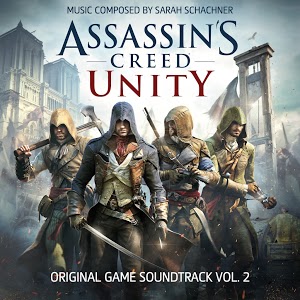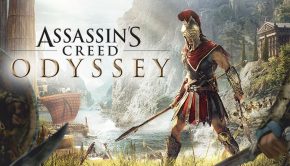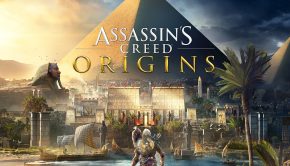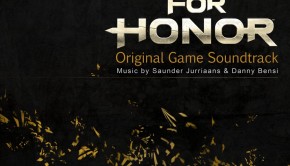Assassin’s Creed -Unity- Original Game Soundtrack Vol. 2
 |
Album Title: Assassin’s Creed -Unity- Original Game Soundtrack Vol. 2 |
| Record Label: Ubisoft |
|
| Catalog No.: N/A |
|
| Release Date: November 11, 2014 |
|
| Purchase: Download at iTunes |
Overview
Assassin’s Creed: Unity is the story of Arno, a young man during the French Revolution who is seeking revenge for the murders of his father and his ward, both killed in the struggle between Assassins and Templar orders. The soundtrack to the game was mainly divided between two composers: Sarah Schachner, a freelance composer who made a several contributions to Bryan Tyler’s score for Assassin’s Creed IV: Black Flag, and Chris Tilton, who has more notably worked alongside Michael Giacchino and scored multiple seasons of the J. J. Abram’s sci-fi television series Fringe. Tilton scored Volume 1 of the score, which includes the music for the main storyline in the game and all the single-player action, while Schachner scored Volume 2, which covers the multiplayer portion of the game. We felt it would work best to cover the albums in two different reviews, as not only are they extremely different, with only one very small thematic similarity, but they must also be purchased separately on both Amazon and iTunes.
Body
Out of the two games and three soundtracks that Ubisoft released with Rogue and Unity, Sarah Schachner wrote what is easily my favorite score. I wrote in my review of Unity Volume 1 that one of my major disappointments with the score was that composer Chris Tilton took no real advantage of the fact that he was writing the music to a game that takes place in one of the richest musical time periods in history — and in one of the cultural epicenters of the Baroque and Classical musical periods. I mean, this game takes place right at the end of Mozart’s career, and Beethoven himself even wrote music inspired by various figures and events of the French Revolution. As a classical music nut (both capital and lowercase “C”), I was very excited to see what the music for Unity would be like, and how the composer would take the time period into consideration. Tilton seemed to essentially ignore it, while Schachner ran with it, incorporating strings of all kinds, from harpsichord, guitar, piano, quartets and orchestras, and even a bowed dulcimer (to replace the more elusive viol de gambe) — the latter was a real treat to hear in a score.
Schachner’s use of Baroque elements is very evident from the second track of the score, “Chandeliers and Carnage,” which opens with a cascade of precise, measured scales from the mid-strings that could be the beginning to a classical symphony except for the rough, jarring cello / bass rhythm, and later the pulsing electronics. The melody is accompanied by a harpsichord, however, making this what might be the only baroque/electronic battle theme I’ve ever heard. The piece is rife with Baroque ornamentations, from mordents to grace notes to trills, and scales and repeats, and ends up being incredibly fun and dynamic. Along with “Ballroom Fight (Invention no. 13 in D Minor),” which features a harpsichord/string duet, it is probably the most historically styled track, albeit modified to include a bass drum. I seriously enjoyed the virtuosic scales and arpeggios. On the whole, pieces like this made for some unusual and invigorating battle misc in the game.
“Dark Slayer” is one of Schachner’s longer pieces, capping out the five minute mark with harsh, frantic strings and low male chorus, eventually bringing in an organ to enhance the dark, dramatic nature of the piece even more. This is one of the only tracks in which Scahchner includes the “Ezio’s Family” theme that also appears in both Volume 1 of the game’s soundtrack as well as the score to Rogue. Schachner uses the low string-and-percussion combo, a la Hans Zimmer, as a kind of instrumental motif throughout the score.
“Danton’s Sacrifice” is one of my favorite tracks on the album, and brings that bass-centered style back to create an extraordinarily percussive and powerful piece representing Danton, one of the characters the player meets during the multiplayer portion of Unity, and one of the many Assassin’s Creed figures that come straight out of the pages of history. Danton was a leading revolutionary, often cited as a key figure in the fall of the French monarchy, and his theme is suitably imposing. The same theme returns in a less percussive and more ominous setting in “Inflame or Englighten,” performed on some celli tremoloing their way across the beautiful melody. I would have loved to hear that melody in more settings throughout the score, not because the music needed it, but just because it makes for such a wonderful theme.
Another popular historical figure commemorated in the soundtrack is Robespierre in “Committee of One,” a complex piece using all sorts of instrumentation from strings to electronics to percussion to brass (which isn’t as common in this score as it is in others), and Baroque runs on the harpsichord. Even the texture of the strings is varied, from staccato to arco, to played entirely at the frog to liberally using the whole bow. The piece itself is interestingly arranged; although the harpsichord receives relatively little time in this piece, its moments of elegant half-motifs and ornamentation binds the track together in a sinister fashion, clearly labeling Robespierre as a more antagonistic force in this realization of the Revolution.
Even the pieces without that level of action contribute to the score. In any other setting, “Legerdemain” would be a filler piece, simply giving the game a musical accompaniment without any contributing any significant themes, but it’s difficult not to enjoy it on some level — it’s kind of beautiful, and the soft and slow strings still convey a sense of Revolutionary pride. The piece picks up simply by adding some gentle percussion and, while maintaining a brisk moderato tempo, ends with a sorrowful melody. “Treachery and Butchers” consists of a series of triplets with hints of piano, reminding me a little of the opening theme of Atonement by Dario Marianelli. The bass percussion, while certainly present in the track is relatively sparse, or at least more subdued than tracks like “Danton’s Sacrifice” and “Ballroom Fight,” and brings a feeling of substance rather than drama to the track. Similarly, “Storming the Guilty” opens with a murky swirl of celli that never really rises above an alternating percussive/arco texture role. Higher violins and counterpoint bring a counterpoint style to the piece, even accompanied by flutes and piccolos, but the piece still captures the listener’s ear through repetition, textured harmonies, and extensively layered instrumentation.
The different pieces vary in mood as well as instrumentation. While tracks like “Chandeliers and Carnage” and “Dark Slayer” feature virtuosic performances and wild energy, “The Nation, The Law, and the King” opens with a simultaneously whimsical and macabre waltz, but ends with a somber set of funeral bells, in an unquestionably finite melody. The last piece on the album, “Execution by All Means” is a short piece, beginning with some harsh ambiance but ending with a frantic string ostinato culminating in an emotion-filled five-note melody repeated once before the piece fades away.
Summary
Overall, Volume 2 of Unity is the best soundtrack of the latest set of Assassin’s Creed scores, and there is little question why. Sarah Schachner combines period instrumentation and technique with varied melodic motifs and electronic sounds to create a diverse, intricate, and extremely fun soundtrack. It is available on iTunes now.
Do you agree with the review and score? Let us know in the comments below!
4
Posted on December 9, 2014 by Emily McMillan. Last modified on December 9, 2014.














